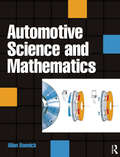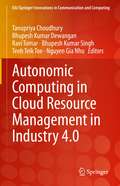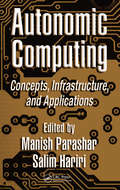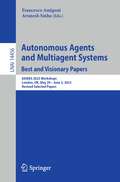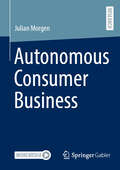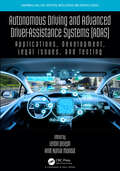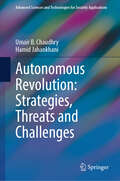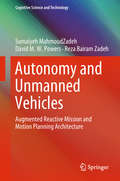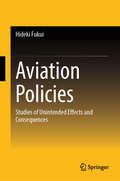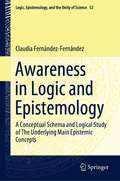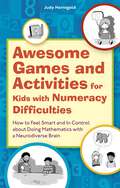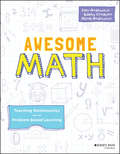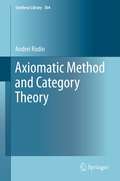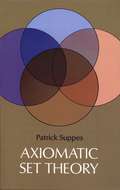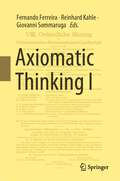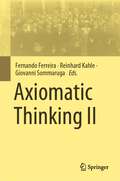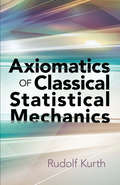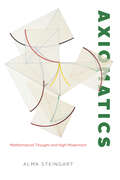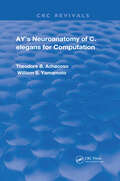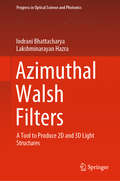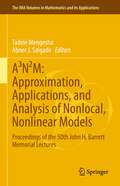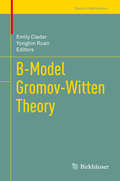- Table View
- List View
Automotive Science and Mathematics
by Allan BonnickAutomotive technicians and students need a firm grasp of science and technology in order to fully appreciate and understand how mechanisms and systems of modern vehicles work. Automotive Science and Mathematics presents the necessary principles and applications with all the examples and exercises relating directly to motor vehicle technology and repair, making it easy for automotive students and apprentices to relate the theory back to their working practice.The coverage of this book is based on the syllabus requirements of the BTEC First in Vehicle Technology, BTEC National in Vehicle Repair and Technology, and the IMI Certificate and Diploma in Vehicle Maintenance and Repair, but will help all automotive students and apprentices at levels 2 and 3 and up to and including HNC/HND, foundation and first degree with their studies and in achieving the Key Skill 'Application of Number' at levels 2 and 3. The book is designed to cater for both light and heavy vehicle courses.Full worked solutions of most exercises are available as a free download for lecturers only from http://textbooks.elsevier.com.Allan Bonnick is a motor vehicle education and training consultant and was formerly Head of Motor Vehicle Engineering, Eastbourne College. He is the author of several established automotive engineering textbooks.
Autonomic Computing in Cloud Resource Management in Industry 4.0 (EAI/Springer Innovations in Communication and Computing)
by Nguyen Gia Nhu Tanupriya Choudhury Ravi Tomar Teoh Teik Toe Bhupesh Kumar Dewangan Bhupesh Kumar SinghThis book describes the next generation of industry—Industry 4.0—and how it holds the promise of increased flexibility in manufacturing, along with automation, better quality, and improved productivity. The authors discuss how it thus enables companies to cope with the challenges of producing increasingly individualized products with a short lead-time to market and higher quality. The authors posit that intelligent cloud services and resource sharing play an important role in Industry 4.0 anticipated Fourth Industrial Revolution. This book serves the different issues and challenges in cloud resource management CRM techniques with proper propped solution for IT organizations. The book features chapters based on the characteristics of autonomic computing with its applicability in CRM. Each chapter features the techniques and analysis of each mechanism to make better resource management in cloud.
Autonomic Computing: Concepts, Infrastructure, and Applications
by Manish Parashar Salim HaririThe complexity of modern computer networks and systems, combined with the extremely dynamic environments in which they operate, is beginning to outpace our ability to manage them. Taking yet another page from the biomimetics playbook, the autonomic computing paradigm mimics the human autonomic nervous system to free system developers and administrators from performing and overseeing low-level tasks. Surveying the current path toward this paradigm, Autonomic Computing: Concepts, Infrastructure, and Applications offers a comprehensive overview of state-of-the-art research and implementations in this emerging area.This book begins by introducing the concepts and requirements of autonomic computing and exploring the architectures required to implement such a system. The focus then shifts to the approaches and infrastructures, including control-based and recipe-based concepts, followed by enabling systems, technologies, and services proposed for achieving a set of "self-*" properties, including self-configuration, self-healing, self-optimization, and self-protection. In the final section, examples of real-world implementations reflect the potential of emerging autonomic systems, such as dynamic server allocation and runtime reconfiguration and repair.Collecting cutting-edge work and perspectives from leading experts, Autonomic Computing: Concepts, Infrastructure, and Applications reveals the progress made and outlines the future challenges still facing this exciting and dynamic field.
Autonomous Agents and Multiagent Systems. Best and Visionary Papers: AAMAS 2023 Workshops, London, UK, May 29 –June 2, 2023, Revised Selected Papers (Lecture Notes in Computer Science #14456)
by Francesco Amigoni Arunesh SinhaThis book contains visionary and best papers from the workshops held at the International Conference on Autonomous Agents and Multiagent Systems, AAMAS 2023, held in London, UK, during May 29–June 2, 2023.The 12 regular papers, 5 best papers and 7 visionary papers, presented were carefully reviewed and selected from a total of more than 110 contributions to the workshops. They focus on emerging topics and new trends in the area of autonomous agents and multiagent systems and stem from the following workshops:- Workshop on Autonomous Robots and Multirobot Systems (ARMS)- Workshop on Adaptive and Learning Agents (ALA)- Workshop on Interdisciplinary Design of Emotion Sensitive Agents (IDEA)- Workshop on Rebellion and Disobedience in Artificial Intelligence (RaD-AI)- Workshop on Neuro-symbolic AI for Agent and Multi-Agent Systems (NeSyMAS)- Workshop on Multiagent Sequential Decision Making under Uncertainty (MSDM)- Workshop on Citizen-Centric Multi-Agent Systems (C-MAS)
Autonomous Consumer Business
by Julian MorgenEine immer mehr digital vernetzte Welt führt zu einer sehr großen Menge von unterschiedlichen Daten, die in Echtzeit generiert werden („Big Data“). Ein großer Teil dieser Datenproduzenten sind Nutzer von Social Media oder auch smarten Geräten, wie bspw. Fitnesstrackern oder mit dem Internet verbundenen Waschmaschinen („IoT“). Unternehmen, die sich diese Daten aus der direkten Lebenswelt der Konsumenten zu Nutze machen, können sehr präzise Einblicke bspw. über Einstellungen, Verhalten oder auch die Bedürfnisse potenzieller Kunden erhalten, wodurch der Weg zu einer „automatisierten Vermarktung“ geebnet wird. Zielsetzung dieses Buches ist die Entwicklung eines Konzeptes für ein Autonomous Consumer Business (ACB), das als maximal eigenständig agierendes und durch Künstliche Intelligenz getragenes Geschäftsmodell verstanden wird, bei dem Unternehmen die Bedürfnisse auf der Konsumentenseite automatisch erkennen und durch entsprechende Leistungsangebote befriedigen können. Weiterhin werden zentrale Bestimmungsgrößen, welche die konsumentenseitige Inanspruchnahme eines ACB im besonderen Maße beeinflussen, sowie potenzielle Kundengruppen empirisch identifiziert, wodurch Hinweise zur konkreten Ausgestaltung eines ACB gewonnen werden können.
Autonomous Driving and Advanced Driver-Assistance Systems: Applications, Development, Legal Issues, and Testing (Chapman & Hall/CRC Artificial Intelligence and Robotics Series)
by Lentin JosephAutonomous Driving and Advanced Driver-Assistance Systems (ADAS): Applications, Development, Legal Issues, and Testing outlines the latest research related to autonomous cars and advanced driver-assistance systems, including the development, testing, and verification for real-time situations of sensor fusion, sensor placement, control algorithms, and computer vision. Features: Co-edited by an experienced roboticist and author and an experienced academic Addresses the legal aspect of autonomous driving and ADAS Presents the application of ADAS in autonomous vehicle parking systems With an infinite number of real-time possibilities that need to be addressed, the methods and the examples included in this book are a valuable source of information for academic and industrial researchers, automotive companies, and suppliers.
Autonomous Revolution: Strategies, Threats and Challenges (Advanced Sciences and Technologies for Security Applications)
by Hamid Jahankhani Umair B. ChaudhryThis book offers a comprehensive dive into the rapidly evolving world of autonomous vehicles and their pivotal role in modern data collection and mission-critical operations. From unmanned vehicles (UVs) navigating complex urban landscapes to traversing remote environments, the integration of advanced algorithms and cloud-based infrastructure enables real-time data acquisition and processing. Topics covered include resilient navigation systems, bio-inspired evolution for safer collaboration, and the crucial governance and security challenges facing land, air, and sea-based UVs. Additionally, the book explores emerging threats, such as cyber-physical vulnerabilities, counter-drone technologies, and the need for secure Flying Ad-Hoc Networks (FANETs). The future of UVs is further examined through the lens of quantum computing, pushing the boundaries of autonomous navigation and decision-making. By compiling these scattered and essential topics into one resource, this book serves as a vital reference for professionals, researchers, and policymakers seeking to understand and shape the future of autonomous systems.
Autonomy and Unmanned Vehicles: Augmented Reactive Mission And Motion Planning Architecture (Cognitive Science And Technology Ser.)
by Somaiyeh MahmoudZadeh Reza Bairam Zadeh David M.W. PowersThis book addresses higher–lower level decision autonomy for autonomous vehicles, and discusses the addition of a novel architecture to cover both levels. The proposed framework’s performance and stability are subsequently investigated by employing different meta-heuristic algorithms. The performance of the proposed architecture is shown to be largely independent of the algorithms employed; the use of diverse algorithms (subjected to the real-time performance of the algorithm) does not negatively affect the system’s real-time performance. By analyzing the simulation results, the book demonstrates that the proposed model provides perfect mission timing and task management, while also guaranteeing secure deployment. Although mainly intended as a research work, the book’s review chapters and the new approaches developed here are also suitable for use in courses for advanced undergraduate or graduate students.
Auxiliary Polynomials in Number Theory
by David MasserThis unified account of various aspects of a powerful classical method, easy to understand in its simplest forms, is illustrated by applications in several areas of number theory. As well as including diophantine approximation and transcendence, which were mainly responsible for its invention, the author places the method in a broader context by exploring its application in other areas, such as exponential sums and counting problems in both finite fields and the field of rationals. Throughout the book, the method is explained in a 'molecular' fashion, where key ideas are introduced independently. Each application is the most elementary significant example of its kind and appears with detailed references to subsequent developments, making it accessible to advanced undergraduates as well as postgraduate students in number theory or related areas. It provides over 700 exercises both guiding and challenging, while the broad array of applications should interest professionals in fields from number theory to algebraic geometry.
Aviation Policies: Studies of Unintended Effects and Consequences
by Hideki FukuiThis book sheds new light on aviation policies&’ unintended effects and consequences, especially regarding infrastructure, environment, and consumer protection. The book provides the reader with the first systematic quantitative analyses of the impacts of airlines&’ strategic reactions to the introduction of airport slot markets, aviation fuel tax, and consumer protection rules. Through extensive empirical investigations, the author reveals that aviation policies based on the regulations and tax can produce both intended and unintended effects and consequences. Although the introduction of airport slot markets was expected to enhance airline competition, airlines&’ manipulative behaviors have impeded the slot markets&’ effective functioning. Also, the aviation fuel tax can reduce emissions in the air transport market effectively, but the amount of the reduction of fuel consumption and CO2 emissions would be smaller in the longer term due to the rebound effect. Finally, the consumer protection rules, e.g., the tarmac delay rule of the US Department of Transportation (DOT) significantly reduced tarmac delays; however, the DOT&’s investigations of tarmac delay incidents triggered the investigated airlines&’ risk-averse behavior, which increased flight cancelations and gate departure delays to avoid violating the rule. The analyses suggest that the most effective way of regulation depends on conditions unique to each policy area; the government should design interventions that circumvent strategic behaviors of subjects or groups that the interventions affect. This book is highly relevant to academics and practitioners interested in understanding the interactive effects between policy interventions and firms&’ strategic reactions.
Awareness in Logic and Epistemology: A Conceptual Schema and Logical Study of The Underlying Main Epistemic Concepts (Logic, Epistemology, and the Unity of Science #52)
by Claudia Fernández-FernándezThis book creates a conceptual schema that acts as a correlation between Epistemology and Epistemic Logic. It connects both fields and offers a proper theoretical foundation for the contemporary developments of Epistemic Logic regarding the dynamics of information. It builds a bridge between the view of Awareness Justification Internalism, and a dynamic approach to Awareness Logic. The book starts with an introduction to the main topics in Epistemic Logic and Epistemology and reviews the disconnection between the two fields. It analyses three core notions representing the basic structure of the conceptual schema: “Epistemic Awareness”, “Knowledge” and “Justification”. Next, it presents the Explicit Aware Knowledge (EAK) Schema, using a diagram of three ellipses to illustrate the schema, and a formal model based on a neighbourhood-model structure, that shows one concrete application of the EAK-Schema into a logical structure. The book ends by presenting conclusions and final remarks about the uses and applications of the EAK-Schema. It shows that the most important feature of the schema is that it serves both as a theoretical correlate to the dynamic extensions of Awareness Logic, providing it with a philosophical background, and as an abstract conceptual structure for a re-interpretation of Epistemology.
Awesome Games and Activities for Kids with Numeracy Difficulties: How to Feel Smart and In Control about Doing Mathematics with a Neurodiverse Brain
by Judy HornigoldHas maths ever made you feel anxious, confused or like you just don't get it? This is an entertaining collection of mathematical games and curiosities for you to astound your family and friends with. You don't have to follow the chapters in a certain order - you can use this book however you would like, whether you want to get creative, play a game or impress your friends with a clever trick.Designed to spark a child's enthusiasm for maths and make learning simple, this book will help children to grasp the fundamental concepts in maths through exploration and play. This book will appeal to all learning styles and abilities but is particularly relevant for those with specific learning difficulties such as dyscalculia. Building self-esteem and promoting a growth mindset, these activities will help readers to effortlessly develop their number skills, empowering even the least confident learner with a deeper understanding of maths.
Awesome Math: Teaching Mathematics with Problem Based Learning
by Titu Andreescu Kathy Cordeiro Alina AndreescuHelp your students to think critically and creatively through team-based problem solving instead of focusing on testing and outcomes. Professionals throughout the education system are recognizing that standardized testing is holding students back. Schools tend to view children as outcomes rather than as individuals who require guidance on thinking critically and creatively. Awesome Math focuses on team-based problem solving to teach discrete mathematics, a subject essential for success in the STEM careers of the future. Built on the increasingly popular growth mindset, this timely book emphasizes a problem-solving approach for developing the skills necessary to think critically, creatively, and collaboratively. In its current form, math education is a series of exercises: straightforward problems with easily-obtained answers. Problem solving, however, involves multiple creative approaches to solving meaningful and interesting problems. The authors, co-founders of the multi-layered educational organization AwesomeMath, have developed an innovative approach to teaching mathematics that will enable educators to: Move their students beyond the calculus trap to study the areas of mathematics most of them will need in the modern world Show students how problem solving will help them achieve their educational and career goals and form lifelong communities of support and collaboration Encourage and reinforce curiosity, critical thinking, and creativity in their students Get students into the growth mindset, coach math teams, and make math fun again Create lesson plans built on problem based learning and identify and develop educational resources in their schools Awesome Math: Teaching Mathematics with Problem Based Learning is a must-have resource for general education teachers and math specialists in grades 6 to 12, and resource specialists, special education teachers, elementary educators, and other primary education professionals.
Axiomatic Method and Category Theory (Synthese Library #364)
by Andrei RodinThis volume explores the many different meanings of the notion of the axiomatic method, offering an insightful historical and philosophical discussion about how these notions changed over the millennia. The author, a well-known philosopher and historian of mathematics, first examines Euclid, who is considered the father of the axiomatic method, before moving onto Hilbert and Lawvere. He then presents a deep textual analysis of each writer and describes how their ideas are different and even how their ideas progressed over time. Next, the book explores category theory and details how it has revolutionized the notion of the axiomatic method. It considers the question of identity/equality in mathematics as well as examines the received theories of mathematical structuralism. In the end, Rodin presents a hypothetical New Axiomatic Method, which establishes closer relationships between mathematics and physics. Lawvere's axiomatization of topos theory and Voevodsky's axiomatization of higher homotopy theory exemplify a new way of axiomatic theory building, which goes beyond the classical Hilbert-style Axiomatic Method. The new notion of Axiomatic Method that emerges in categorical logic opens new possibilities for using this method in physics and other natural sciences. This volume offers readers a coherent look at the past, present and anticipated future of the Axiomatic Method.
Axiomatic Set Theory
by Patrick SuppesOne of the most pressingproblems of mathematics over the last hundred years has been the question: What is a number? One of the most impressive answers has been the axiomatic development of set theory. The question raised is: "Exactly what assumptions, beyond those of elementary logic, are required as a basis for modern mathematics?" Answering this question by means of the Zermelo-Fraenkel system, Professor Suppes' coverage is the best treatment of axiomatic set theory for the mathematics student on the upper undergraduate or graduate level. The opening chapter covers the basic paradoxes and the history of set theory and provides a motivation for the study. The second and third chapters cover the basic definitions and axioms and the theory of relations and functions. Beginning with the fourth chapter, equipollence, finite sets and cardinal numbers are dealt with. Chapter five continues the development with finite ordinals and denumerable sets. Chapter six, on rational numbers and real numbers, has been arranged so that it can be omitted without loss of continuity. In chapter seven, transfinite induction and ordinal arithmetic are introduced and the system of axioms is revised. The final chapter deals with the axiom of choice. Throughout, emphasis is on axioms and theorems; proofs are informal. Exercises supplement the text. Much coverage is given to intuitive ideas as well as to comparative development of other systems of set theory. Although a degree of mathematical sophistication is necessary, especially for the final two chapters, no previous work in mathematical logic or set theory is required. For the student of mathematics, set theory is necessary for the proper understanding of the foundations of mathematics. Professor Suppes in Axiomatic Set Theory provides a very clear and well-developed approach. For those with more than a classroom interest in set theory, the historical references and the coverage of the rationale behind the axioms will provide a strong background to the major developments in the field. 1960 edition.
Axiomatic Thinking I
by Giovanni Sommaruga Reinhard Kahle Fernando FerreiraIn this two-volume compilation of articles, leading researchers reevaluate the success of Hilbert's axiomatic method, which not only laid the foundations for our understanding of modern mathematics, but also found applications in physics, computer science and elsewhere.The title takes its name from David Hilbert's seminal talk Axiomatisches Denken, given at a meeting of the Swiss Mathematical Society in Zurich in 1917. This marked the beginning of Hilbert's return to his foundational studies, which ultimately resulted in the establishment of proof theory as a new branch in the emerging field of mathematical logic. Hilbert also used the opportunity to bring Paul Bernays back to Göttingen as his main collaborator in foundational studies in the years to come.The contributions are addressed to mathematical and philosophical logicians, but also to philosophers of science as well as physicists and computer scientists with an interest in foundations.Chapter 8 is available open access under a Creative Commons Attribution 4.0 International License via link.springer.com.
Axiomatic Thinking II
by Giovanni Sommaruga Reinhard Kahle Fernando FerreiraIn this two-volume compilation of articles, leading researchers reevaluate the success of Hilbert's axiomatic method, which not only laid the foundations for our understanding of modern mathematics, but also found applications in physics, computer science and elsewhere.The title takes its name from David Hilbert's seminal talk Axiomatisches Denken, given at a meeting of the Swiss Mathematical Society in Zurich in 1917. This marked the beginning of Hilbert's return to his foundational studies, which ultimately resulted in the establishment of proof theory as a new branch in the emerging field of mathematical logic. Hilbert also used the opportunity to bring Paul Bernays back to Göttingen as his main collaborator in foundational studies in the years to come.The contributions are addressed to mathematical and philosophical logicians, but also to philosophers of science as well as physicists and computer scientists with an interest in foundations.
Axiomatics of Classical Statistical Mechanics (Dover Books on Physics #Volume 11)
by Rudolf KurthRequiring only familiarity with elements of calculus and analytical geometry, this monograph constructs classical statistical mechanics as a deductive system, based on equations of motion and basic postulates of probability. 1960 edition.
Axiomatics: Mathematical Thought and High Modernism
by Alma SteingartThe first history of postwar mathematics, offering a new interpretation of the rise of abstraction and axiomatics in the twentieth century. Why did abstraction dominate American art, social science, and natural science in the mid-twentieth century? Why, despite opposition, did abstraction and theoretical knowledge flourish across a diverse set of intellectual pursuits during the Cold War? In recovering the centrality of abstraction across a range of modernist projects in the United States, Alma Steingart brings mathematics back into the conversation about midcentury American intellectual thought. The expansion of mathematics in the aftermath of World War II, she demonstrates, was characterized by two opposing tendencies: research in pure mathematics became increasingly abstract and rarified, while research in applied mathematics and mathematical applications grew in prominence as new fields like operations research and game theory brought mathematical knowledge to bear on more domains of knowledge. Both were predicated on the same abstractionist conception of mathematics and were rooted in the same approach: modern axiomatics. For American mathematicians, the humanities and the sciences did not compete with one another, but instead were two complementary sides of the same epistemological commitment. Steingart further reveals how this mathematical epistemology influenced the sciences and humanities, particularly the postwar social sciences. As mathematics changed, so did the meaning of mathematization. Axiomatics focuses on American mathematicians during a transformative time, following a series of controversies among mathematicians about the nature of mathematics as a field of study and as a body of knowledge. The ensuing debates offer a window onto the postwar development of mathematics band Cold War epistemology writ large. As Steingart’s history ably demonstrates, mathematics is the social activity in which styles of truth—here, abstraction—become synonymous with ways of knowing.
Axiomatics: Mathematical Thought and High Modernism
by Alma SteingartThe first history of postwar mathematics, offering a new interpretation of the rise of abstraction and axiomatics in the twentieth century. Why did abstraction dominate American art, social science, and natural science in the mid-twentieth century? Why, despite opposition, did abstraction and theoretical knowledge flourish across a diverse set of intellectual pursuits during the Cold War? In recovering the centrality of abstraction across a range of modernist projects in the United States, Alma Steingart brings mathematics back into the conversation about midcentury American intellectual thought. The expansion of mathematics in the aftermath of World War II, she demonstrates, was characterized by two opposing tendencies: research in pure mathematics became increasingly abstract and rarified, while research in applied mathematics and mathematical applications grew in prominence as new fields like operations research and game theory brought mathematical knowledge to bear on more domains of knowledge. Both were predicated on the same abstractionist conception of mathematics and were rooted in the same approach: modern axiomatics. For American mathematicians, the humanities and the sciences did not compete with one another, but instead were two complementary sides of the same epistemological commitment. Steingart further reveals how this mathematical epistemology influenced the sciences and humanities, particularly the postwar social sciences. As mathematics changed, so did the meaning of mathematization. Axiomatics focuses on American mathematicians during a transformative time, following a series of controversies among mathematicians about the nature of mathematics as a field of study and as a body of knowledge. The ensuing debates offer a window onto the postwar development of mathematics band Cold War epistemology writ large. As Steingart’s history ably demonstrates, mathematics is the social activity in which styles of truth—here, abstraction—become synonymous with ways of knowing.
Axiomatics: Mathematical Thought and High Modernism
by Alma SteingartThe first history of postwar mathematics, offering a new interpretation of the rise of abstraction and axiomatics in the twentieth century. Why did abstraction dominate American art, social science, and natural science in the mid-twentieth century? Why, despite opposition, did abstraction and theoretical knowledge flourish across a diverse set of intellectual pursuits during the Cold War? In recovering the centrality of abstraction across a range of modernist projects in the United States, Alma Steingart brings mathematics back into the conversation about midcentury American intellectual thought. The expansion of mathematics in the aftermath of World War II, she demonstrates, was characterized by two opposing tendencies: research in pure mathematics became increasingly abstract and rarified, while research in applied mathematics and mathematical applications grew in prominence as new fields like operations research and game theory brought mathematical knowledge to bear on more domains of knowledge. Both were predicated on the same abstractionist conception of mathematics and were rooted in the same approach: modern axiomatics. For American mathematicians, the humanities and the sciences did not compete with one another, but instead were two complementary sides of the same epistemological commitment. Steingart further reveals how this mathematical epistemology influenced the sciences and humanities, particularly the postwar social sciences. As mathematics changed, so did the meaning of mathematization. Axiomatics focuses on American mathematicians during a transformative time, following a series of controversies among mathematicians about the nature of mathematics as a field of study and as a body of knowledge. The ensuing debates offer a window onto the postwar development of mathematics band Cold War epistemology writ large. As Steingart’s history ably demonstrates, mathematics is the social activity in which styles of truth—here, abstraction—become synonymous with ways of knowing.
Ay's Neuroanatomy of C. Elegans for Computation (Routledge Revivals)
by Theodore B. Achacoso William S. YamamotoFirst published in 1992, AY's Neuroanatomy of C. elegans for Computation provides the neural circuitry database of the nematode Caenorhabditis elegans, both in printed form and in ASCII files on 5.25-inch diskettes (for use on IBM® and compatible personal computers, Macintosh® computers, and higher level machines). Tables of connections among neuron classes, synapses among individual neurons, gap junctions among neurons, worm cells and their embryonic origin, and synthetically derived neuromuscular connections are presented together with the references from which the data were compiled and edited. Sample data files and source codes of FORTRAN and BASIC programs are provided to illustrate the use of mathematical tools for any researcher or student interested in examining a natural neural network and discovering what makes it tick.
Azimuthal Walsh Filters: A Tool to Produce 2D and 3D Light Structures (Progress in Optical Science and Photonics #10)
by Indrani Bhattacharya Lakshminarayan HazraThis book explores the possibility of using azimuthal Walsh filters as an effective tool for manipulating far-field diffraction characteristics near the focal plane of rotationally symmetric imaging systems. It discusses the generation and synthesis of azimuthal Walsh filters, and explores the inherent self-similarity presented in various orders of these filters, classifying them into self-similar groups and sub-groups. Further, it demonstrates that azimuthal Walsh filters possess a unique rotational self-similarity exhibited among adjacent orders. Serving as an atlas of diffraction phenomena with pupil functions represented by azimuthal Walsh filters of different orders, this book describes how orthogonality and self-similarity of these filters could be harnessed to sculpture 2D and 3D light distributions near the focus.
A³N²M: Proceedings of the 50th John H. Barrett Memorial Lectures (The IMA Volumes in Mathematics and its Applications #165)
by Tadele Mengesha Abner J. SalgadoThis volume collects papers based on plenary and invited talks given at the 50th Barrett Memorial Lectures on Approximation, Applications, and Analysis of Nonlocal, Nonlinear Models that was organized by the University of Tennessee, Knoxville and held virtually in May 2021. The three-day meeting brought together experts from the computational, scientific, engineering, and mathematical communities who work with nonlocal models. These proceedings collect contributions and give a survey of the state of the art in computational practices, mathematical analysis, applications of nonlocal models, and explorations of new application domains. The volume benefits from the mixture of contributions by computational scientists, mathematicians, and application specialists. The content is suitable for graduate students as well as specialists working with nonlocal models and covers topics on fractional PDEs, regularity theory for kinetic equations, approximation theory for fractional diffusion, analysis of nonlocal diffusion model as a bridge between local and fractional PDEs, and more.
B-Model Gromov-Witten Theory (Trends in Mathematics)
by Emily Clader Yongbin RuanThis book collects various perspectives, contributed by both mathematicians and physicists, on the B-model and its role in mirror symmetry. Mirror symmetry is an active topic of research in both the mathematics and physics communities, but among mathematicians, the “A-model” half of the story remains much better-understood than the B-model. This book aims to address that imbalance. It begins with an overview of several methods by which mirrors have been constructed, and from there, gives a thorough account of the “BCOV” B-model theory from a physical perspective; this includes the appearance of such phenomena as the holomorphic anomaly equation and connections to number theory via modularity. Following a mathematical exposition of the subject of quantization, the remainder of the book is devoted to the B-model from a mathematician’s point-of-view, including such topics as polyvector fields and primitive forms, Givental’s ancestor potential, and integrable systems.
